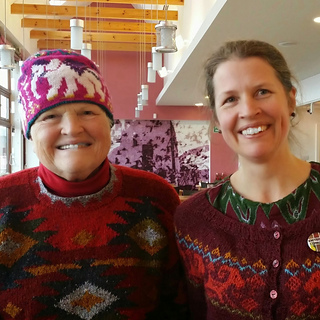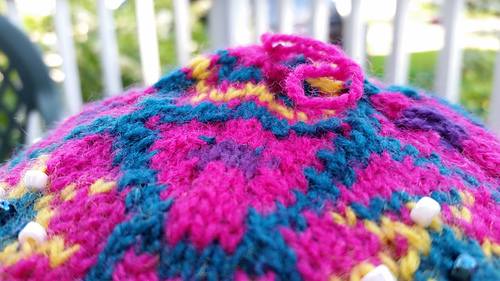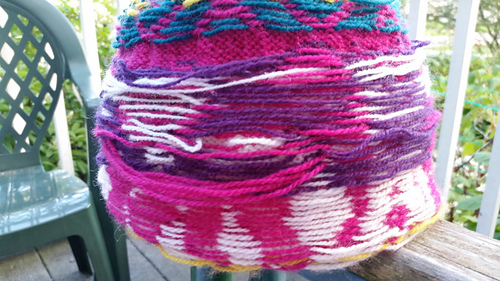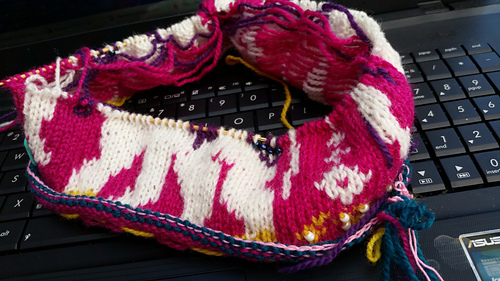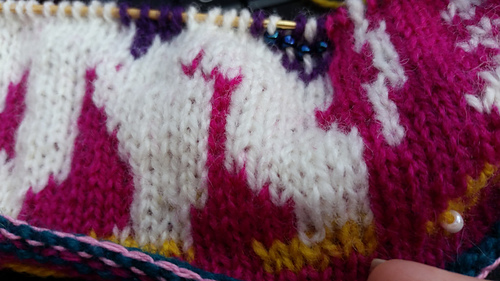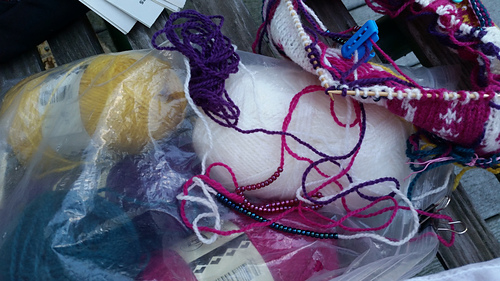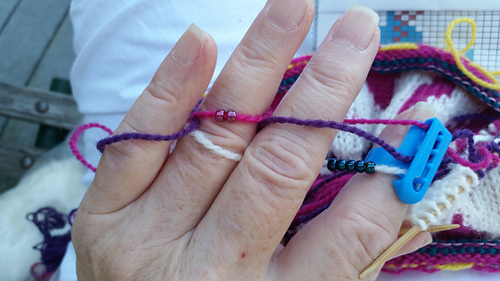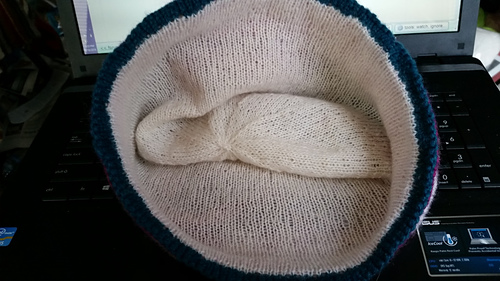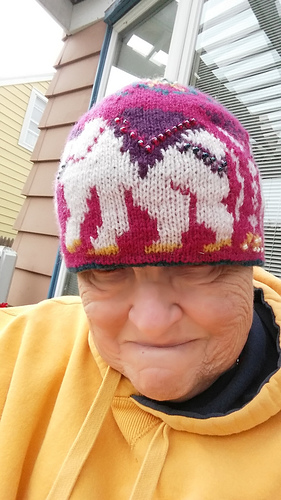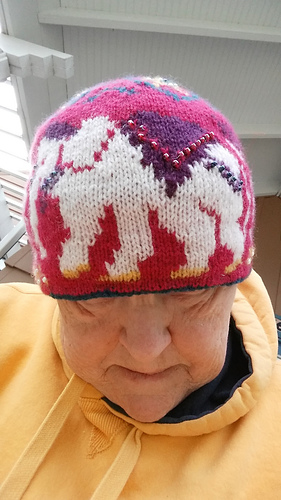9/7/2014 I met Tori Seiersad, the designer of my hat! Actually, I sort of ambushed her in the museum restaurant in Lerwick. Not often elephants are seen in the wild in Shetland , I bet. A Wool Week highlight for me.
8/2014 Um, 4+ years later I’m back at it. I’ve always thought of myself as having this bright pink hat with elephants; I just conveniently overlooked the fact that it was hardly knitted up at all…and then I had to start over anyway.
Experience since 2010 has shown me that the needles I was using were too large, so I ripped back to ground zero, Round 2 for this project. Starting over except for the bead prep, I began a size small, playing Gauge Chicken…and also losing Round 3. When I got to lower body of the elephants, I tried it on and it was too small. On to Round 4. I do love working with this yarn; it’s wonderful for stranded colorwork; a new fave.
I’ve been knitting for more than 50 years, and I can’t remember ever having worked on a project that challenged me as much as this one. Bigger projects yes, more frustrating yes, but oh my! I’ve never worked beads and colorwork together before, and that part was fun. But the extensive 3-colors/round colorwork way less so, and the exceedingly long floats…wow! I worked several rounds on the body with three colors/round and hated the way the intense purple and fuchsia showed through the white where I trapped them. So I ripped that bit out and settled for obnoxiously long floats, counting on some final float and the already-planned full lining to fix it up at the end. It’s hardly a perfect solution but it is what it is. When I did trap floats, whenever I could, I trapped them over several stitches where possible, to good effect.
After decreasing the nine stitches after chart C, I still had 6 extra stitches, so I added a column on the left of Chart D, which means 6 extra stitches to deal with at end of Chart D. I also shifted the start of round so that Chart D was centered over the (purple) motif at end of Chart C.
9/1/2014
I’m calling it “done,” even though that isn’t strictly true. It’s sitting on the “blocking bowl” (thrift store find that never made it to the kitchen because it turned out to be exactly the size of my head), but it’s not quite ready for blocking. The shot of the inside shows that my floats are in need of some surgery. The semi-long floats will be fine because this “super-sticky” wool readily melds to itself. (I do love me some sticky wool for colorwork and this is my Best Ever sticky wool yarn.) Those obnoxiously long floats…I’m not going to even attempt to tack down because they will be hidden by lining.
The top of the hat is a tad pointy for my taste. I often go down a needle size part way into the top shaping, and then even another size for the last few rows to flatten the top. In this case, I didn’t do that; in fact I even added a round to reduce my stitch count from 36 to 24 before a k2tog across round at the end . I’m counting on blocking to flatten the top a bit.
The provisional CO is waiting for another lightweight cashmere hat to be knitted on the inside for both scratchiness and aesthetics. This will be one warm hat--much of the stranding in the wool is essentially three layers, and then comes a warm lining.
2/2008
I was originally a bit confused about the beads’ numbers, but that has been somewhat clarified by the errata. I used #6 beads. ETA I had beads of each color left over threaded on to my working yarns. Can’t see where I left any off. One was mysteriously on the inside on one of the floats, oops, and needed to be returned to right side of the stitch it strayed away from.
When I became infatuated with this pattern, I didn’t think “Gee, I’m going to make a little $55 hat,” but, well…love happens… The pattern was $3.50 but it was for a good cause, Haiti Relief 8>); then $40 for yarn; $11 for beads; I’m not counting the reclaimed cashmere I’m planning to use as lining. Ain’t love grand?
 knotjusthats >
knotjusthats >  notebook > projects > Phuschia Phantasy
notebook > projects > Phuschia Phantasy 

29091 projects
stashed
18143 times


 handspun
handspun queue
queue favorites
favorites friends
friends needles & hooks
needles & hooks library
library